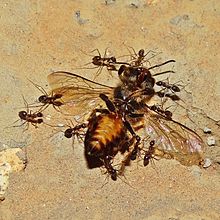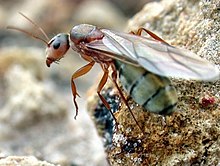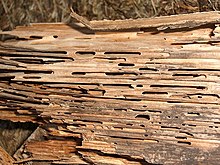Carpenter ant
| Carpenter ant | |
|---|---|

| |
| Camponotus sp. (worker) | |
| Scientific classification | |
| Domain: | Eukaryota |
| Kingdom: | Animalia |
| Phylum: | Arthropoda |
| Class: | Insecta |
| Order: | Hymenoptera |
| Family: | Formicidae |
| Subfamily: | Formicinae |
| Tribe: | Camponotini |
| Genus: | Camponotus Mayr, 1861 |
| Type species | |
| Formica ligniperda Latreille, 1802
| |
| Diversity | |
| > 1,000 species | |
| Synonyms[1] | |
| |
Carpenter ants (Camponotus spp.) are large
They build nests inside wood, consisting of galleries chewed out with their mandibles or jaws, preferably in dead, damp wood. However, unlike termites, they do not consume wood,[3] but instead discard a material that resembles sawdust outside their nest. Sometimes, carpenter ants hollow out sections of trees. They also commonly infest wooden buildings and structures, causing a widespread problem: they are a major cause of structural damage. Nevertheless, their ability to excavate wood helps in forest decomposition. The genus includes over 1,000 species.[4] They also farm aphids. In their farming, the ants protect the aphids from predators (usually other insects) while they excrete a sugary fluid called honeydew, which the ants get by stroking the aphids with their antennae.
Description
Carpenter ants are generally large ants: workers are 4–7 mm long in small species and 7–13 mm in large species, queens are 9–20 mm long and males are 5–13 mm long. The bases of the antennae are separated from the clypeal border by a distance of at least the antennal scape's maximum diameter. The mesosoma in profile usually forms a continuous curve from the pronotum through to the propodeum.[5][6]
Habitat

Carpenter ant species reside both outdoors and indoors in moist, decaying, or hollow wood, most commonly in forest environments. They cut "galleries" into the wood grain to provide passageways to allow for movement between different sections of the nest. Certain parts of a house, such as around and under windows, roof eaves, decks and porches, are more likely to be infested by carpenter ants because these areas are most vulnerable to moisture.[7]

Carpenter ants have been known to construct extensive underground tunneling systems. These systems often end at some food source – often aphid colonies, where the ants extract and feed on honeydew. These tunneling systems also often exist in trees. The colonies typically include a central "parent" colony surrounded and supplemented by smaller satellite colonies.[8]
Food

Carpenter ants are considered both predators and scavengers. These ants are foragers that typically eat parts of other dead insects or substances derived from other insects. Common foods for them include insect parts, "
Most species of carpenter ants forage at night. When foraging, they usually collect and consume dead insects. Some species less commonly collect live insects. When they discover a dead insect, workers surround it and extract its body fluids to be carried back to the nest. The remaining
Although carpenter ants do not tend to be extremely aggressive, they have developed mechanisms to maximize what they take from a food source when that same food source is also visited by competing organisms. This is accomplished in different ways. Sometimes they colonize an area near a relatively static food supply. More often, they develop a systemic way to visit the food source, with alternating trips by different individual ants or groups. This allows them to decrease the gains of intruders because the intruders tend to visit in a scattered, random, and unorganized manner. The ants, however, visit the sources systematically so that they reduce the average crop remaining. They tend to visit more resource-dense food areas in an attempt to minimize resource availability for others. That is, the more systematic the foraging behavior of the ants, the more random that of its competitors.[13]
Contrary to popular belief, carpenter ants do not actually eat wood, as they are unable to digest cellulose. They only create tunnels and nests within it.[14]
Some carpenter ant species can obtain nitrogen by feeding on urine or urine-stained sand. This may be beneficial in nitrogen-limited environments.[15]
Symbionts
All ants in this genus, and some related genera, possess an
Behavior and ecology
Nesting



Carpenter ants work to build the nests that house eggs in environments with usually high humidity due to their sensitivity to environmental humidity. These nests are called primary nests. Satellite nests are constructed once the primary nest is established and has begun to mature. Residents of satellite nests include older
Nuptial flight
When conditions are warm and humid, winged males and females participate in a nuptial flight. They emerge from their satellite nests and females mate with a number of males while in flight. The males die after mating. These newly fertilized queens discard their wings and search for new areas to establish primary nests. The queens build new nests and deposit around 20 eggs, nurturing them as they grow until worker ants emerge. The worker ants eventually assist her in caring for the brood as she lays more eggs. After a few years, reproductive winged ants are born, allowing for the making of new colonies. Again, satellite nests will be established and the process will repeat itself.[18]
Relatedness
Genetic diversity
Kin recognition
According to
The process of recognition for carpenter ants requires two events. First, a cue must be present on a "donor animal". These cues are called "labels". Next, the receiving animal must be able to recognize and process the cue. In order for an individual carpenter ant to be recognized as a nestmate, it must, as an adult, go through specific interactions with older members of the nest.[21] This process is also necessary in order for the ant to recognize and distinguish other individuals. If these interactions do not occur in the beginning of adult life, the ant will be unable to be distinguished as a nestmate and unable to distinguish nestmates.[23]
Kin altruism
Recognition allows for the presence of kin-specific interactions, such as kin altruism. Altruistic individuals increase other individuals' fitness at the expense of their own. Carpenter ants perform altruistic actions toward their nestmates so that their shared genes are propagated more readily or more often. In many social insect species like these ants, many worker animals are sterile and do not have the ability to reproduce. As a result, they forgo reproduction to donate energy and help the fertile individuals reproduce.[citation needed]
Pheromones
As in most other social insect species, individual interaction is heavily influenced by the queen. The queen can influence individuals with odors called
Social immunity
In many social insect species, social behavior can increase the disease resistance of animals. This phenomenon, called
Polygyny
Polygyny often is associated with many social insect species, and usually is characterized by limited mating flights, small queen size, and other characteristics. However, carpenter ants have "extensive" mating flights and relatively large queens, distinguishing them from polygynous species. Carpenter ants are described as oligogynous because they have a number of fertile queens which are intolerant of each other and must therefore spread to different areas of the nest. Some aggressive interactions have been known to take place between queens, but not necessarily through workers. Queens become aggressive mainly to other queens if they trespass on a marked territory. Queens in a given colony can work together in brood care[8] and the workers tend to experience higher rates of survival in colonies with multiple queens. Some researchers still subscribe to the notion that carpenter ant colonies are only monogynous.[26]
Exploding ants
In at least nine
The termite species Globitermes sulphureus has a similar defensive system.[32]
Selected species




- Camponotus aeneopilosusMayr, 1862 – golden tail sugar ant
- Camponotus amaurus (Espadaler, 1997)
- Camponotus americanus
- Camponotus anderseni
- Camponotus atriceps – Florida carpenter ant (cf. C. floridanus)
- Camponotus bishamon
- Camponotus chromaiodes – red carpenter ant
- Camponotus cinctellus – shiny sugar ant
- Camponotus compressus (Fabricius, 1787)
- Camponotus consobrinus– banded sugar ant
- Camponotus crassus Mayr, 1862
- Camponotus cruentatus (Latreille, 1802)
- Camponotus daitoensis
- Camponotus detritusEmery, 1886 – Namib Desert dune ant
- Camponotus empedocles – glossy sugar ant
- Camponotus fellah (Dalla Torre, 1983)
- Camponotus ferrugineus – red carpenter ant
- Camponotus festinatus (Buckley, 1866)
- Camponotus flavomarginatus Mayr, 1862
- Camponotus floridanus, Florida carpenter ant, genome 90% sequenced[33]
- Camponotus haroi (Espadaler, 1997)
- Camponotus herculeanus (Linnaeus, 1758) – Hercules ant
- Camponotus japonicus Mayr, 1866 – Japanese carpenter ant
- Camponotus kaura
- Camponotus ligniperda, a common species in Europe
- Camponotus modoc Wheeler, W. M., 1910 – western carpenter ant
- Camponotus monju
- Camponotus nearcticus (Emery) – smaller carpenter ant
- Camponotus nigriceps(Smith, 1858) – black-headed sugar ant
- Camponotus novaeboracensis
- Camponotus pennsylvanicus(DeGeer) – black carpenter ant
- Camponotus reburrus Mackay, in Mackay & Barriga, 2012
- Camponotus punctulatus (Mayr) – Tacuru ant
- Camponotus saundersi
- Camponotus schmitziStärke, 1933 – diving ant
- Camponotus sericeiventris
- Camponotus sericeus
- Camponotus silvestrii Emery, 1906
- Camponotus taino
- Camponotus tortuganus (Emery) – Tortugas carpenter ant
- Camponotus triodiae
- Forel, 1890
- Camponotus vagus Scopoli, 1763
- Camponotus variegatus (Smith, F., 1858) – Hawaiian carpenter ant
Relationship with humans
One of the most familiar species associated with human habitation in the United States is the black carpenter ant (Camponotus pennsylvanicus).[citation needed]
As pests
Carpenter ants can damage wood used in the construction of buildings. They can leave behind a sawdust-like material called frass that provides clues to their nesting location. Carpenter ant galleries are smooth and very different from termite-damaged areas, which have mud packed into the hollowed-out areas. Carpenter ants can be identified by the general presence of one upward protruding node, looking like a spike, at the "waist" attachment between the thorax and abdomen (petiole).[34] Control involves application of insecticides in various forms including dusts and liquids. The dusts are injected directly into galleries and voids where the carpenter ants are living. The liquids are applied in areas where foraging ants are likely to pick the material up and spread the poison to the colony upon returning.[35]
As food

Carpenter ants and their larvae are eaten in various parts of the world. In Australia, the
In North America, lumbermen during the early years in Maine would eat carpenter ants to prevent scurvy,[40] and in John Muir's publication, First Summer in the Sierra, Muir notes that the Northern Paiute people of California ate the tickling, acid gasters of the large jet-black carpenter ants.[41] In Africa, carpenter ants are among a vast number of species that are consumed by the San people.[42]
References
- ^ Johnson, Norman F. (December 19, 2007). "Camponotus Mayr". Hymenoptera Name Server version 1.5. Columbus, Ohio, USA: Ohio State University. Archived from the original on April 16, 2015. Retrieved April 1, 2015.
- ISBN 978-1-4008-4892-8.
- ^ "Carpenter ants: Insects: University of Minnesota Extension". Extension.umn.edu. 2012-10-15. Archived from the original on 2012-06-09. Retrieved 2015-05-12.
- PMID 17971224.
- ^ "Genus Camponotus - Carpenter Ants". bugguide.net. Retrieved 2022-11-23.
- ^ "Key to North American Genera of Formicinae - AntWiki". antwiki.org. Retrieved 2022-11-23.
- ^ "Carpenter Ant Damage In The Home - Four Common Areas". EnviroPest Solutions. 13 March 2021.
- ^ a b Colony Size and Polygyny in Carpenter Ants (Hymenoptera: Formicidae) Roger D. Akre, Laurel D. Hansen and Elizabeth A. Myhre Journal of the Kansas Entomological Society , Vol. 67, No. 1 (January 1994), pp. 1–9
- ^ Pricer, John. The Life History of the Carpenter Ant. Biological Bulletin , Vol. 14, No. 3 (Feb., 1908), pp. 177-218
- S2CID 37065825.
- ^ B.Colyott, firsthand observation over a several year period.
- S2CID 44043578.
- ^ "Carpenter Ants: 3 Consistent Patterns That Make Their Competition's Foraging More Unpredictable". 1999. Archived from the original on 2016-09-15. Retrieved 2016-09-03.
- ^ Hahn, Jeff. "Carpenter Ants": Insects: University of Minnesota Extension. N.p., n.d. Web. October 1, 2013.
- S2CID 214448821.
- PMID 17971224.
- S2CID 3387710. Retrieved 2021-06-09.
- ^ a b Pararas — Carayannis, Carolyn. "Carpenter Ants". Colony Behaviors of Carpenter Ants. Web. October 1, 2013.
- ^ .
- ISBN 978-1-4612-8311-9.
- ^ S2CID 53150854.
- S2CID 38728014.
- S2CID 43987360.
- ^ H.G. Fowler and R. B. Roberts Journal of the Kansas Entomological Society, Vol. 55, No. 3 (July 1982), pp. 568–570
- PMID 20591850.
- S2CID 20368901.
- S2CID 23756265.
- ^ Emery, Carlo (1889). Viaggio di Leonardo Fea in Birmania e regioni vicine. XX. Formiche di Birmania e del Tenasserim raccolte da Leonardo Fea (1885–87). Annali del Museo Civico di Storia Naturale Giacomo Doria (Genova) 2 7(27): 485–520. [PDF]
- ^ "Utahn enters world of exploding ants". Deseret News. September 11, 2002. Archived from the original on July 9, 2010. Retrieved September 27, 2009. University of Utah graduate student Steve Cook explained "They've been called kamikaze ants by other researchers because they tend to explode or self-destruct when they're attacked or harassed in any way."
- ^ Vittachi, Nury (June 6, 2008). "The Malaysian ant teaches us all how to go out with a bang". Daily Star. Dhaka.
- ISBN 0-86542-390-3. Retrieved 2009-09-26.
- ISBN 978-0-7614-7334-3.
- doi:10.5524/100018.
- ^ Davis, Ryan; Young, Deborah; Johnson, Kelsie; Armenta, Roberta; Berry, Genevieve. "Common Structural and Health-Related Pests of Utah" (PDF). USU School Integrated Pest Management. Utah State University Extension and Colorado State University Extension. Retrieved September 7, 2020.
- ^ "Maxforce Carpenter Ant Bait Gel Directions for Use". Archived from the original on 14 August 2018. Retrieved 14 Aug 2018.
- ^ Capinera 2008, p. 1342.
- ^ Resh & Cardé 2009, p. 381.
- ^ Gullan & Cranston 2010, p. 13.
- PMID 37520253.
- ^ Srivastava, S.K.; Babu, Naresh; Pandey, Hema (2009). "Traditional insect bioprospecting-As human food and medicine" (PDF). Indian Journal of Traditional Knowledge. 8 (4): 485–494. Retrieved 16 April 2015.
- ^ Bequaert J (1921). "Insects as food: How they have augmented the food supply of mankind in early and recent times". Natural History Journal. 21: 191–200.
- ^ Morris 2006, p. 52.
Cited texts
- Capinera, John L. (2008). Encyclopedia of Entomology. Springer Science & Business Media. ISBN 978-1-4020-6242-1.
- Morris, Brian (2006). Insects and Human Life. Berg. ISBN 978-1-84520-949-0.
- Resh, Vincent H.; Cardé, Ring T. (2009). Encyclopedia of Insects. Academic Press. ]
- Gullan, P.J.; Cranston, P.S. (2010). The Insects: An Outline of Entomology (4th ed.). John Wiley & Sons. ISBN 978-1-4443-1767-1.
Further reading
- Mayr, Gustav (1861): Die europäischen Formiciden. Vienna. PDF—original description of p. 35
- McArthur, Archie J (2007): A Key to Camponotus Mayr of Australia. In: Snelling, R.R., B.L. Fisher and P.S. Ward (eds). Advances in ant systematics (Hymenoptera: Formicidae): homage to E. O. Wilson – 50 years of contributions. Memoirs of the American Entomological Institute 80. PDF — 91 species, 10 subspecies
External links
- Carpenter Ant Information
- University of Kentucky Extension Fact Sheet
- Ohio State University Extension Fact Sheet
- Carpenter Ant Fact Sheet from the National Pest Management Association with information on habits, habitat and prevention
- Carpenter Ants An online supplemental to "Carpenter Ants: Biology and Control" by Laurel Hansen, Ph.D. of Spokane Falls Community College
